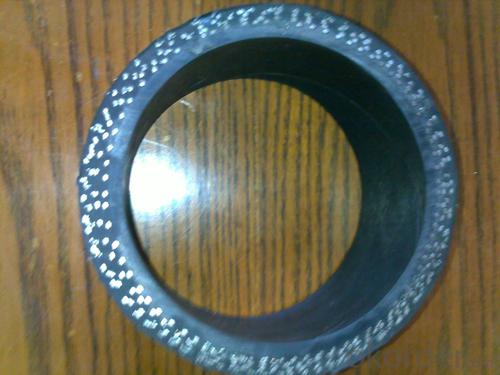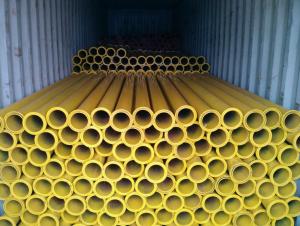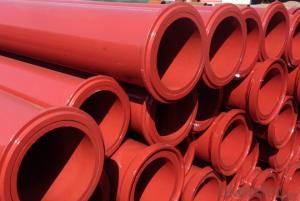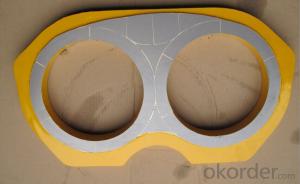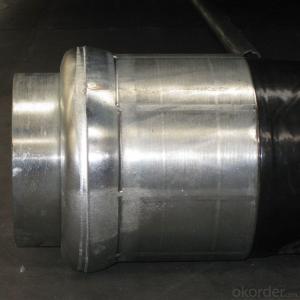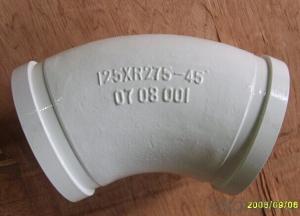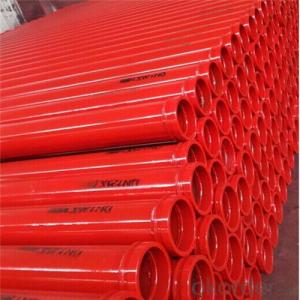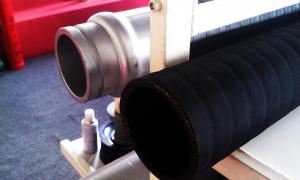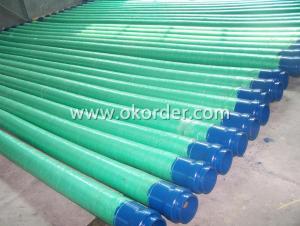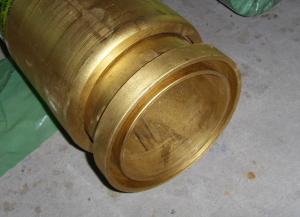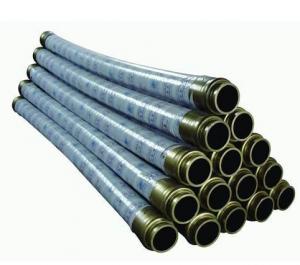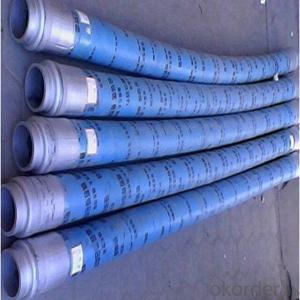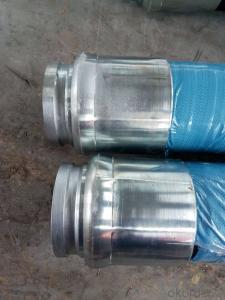Concrete Pump Rubber End Hose with 4 Steel wire
- Loading Port:
- China Main Port
- Payment Terms:
- TT OR LC
- Min Order Qty:
- -
- Supply Capability:
- -
OKorder Service Pledge
OKorder Financial Service
You Might Also Like

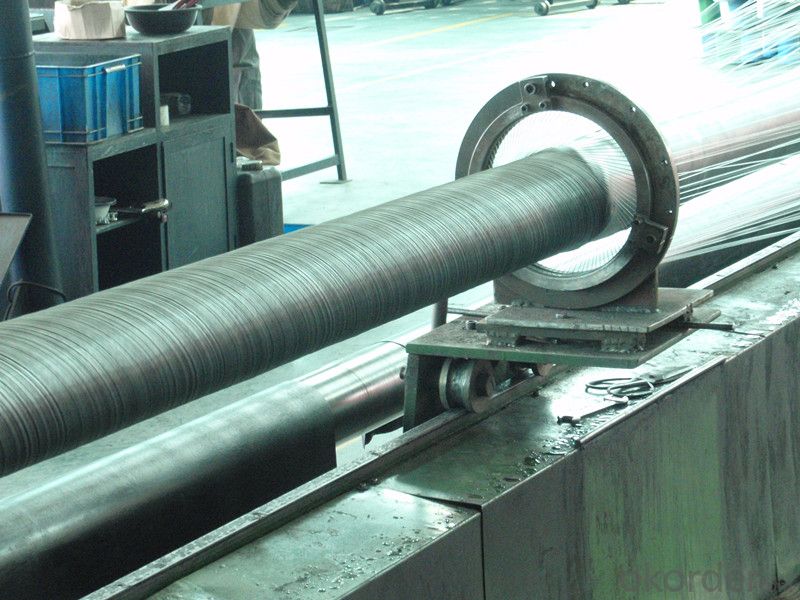
Detailed Product Description
rubber hoses concrete pump
1.Steel hose
2.4 plies of steel wire
3.Work Pressure:85BAR(1250PSI)
4.Burst Pressure:200 BAR (2940PSI)4
5.Working life:20000m³
6.The inside of hose is high abrasion resistant.
7.Integrated hose end and inner wall harden,prolong work life.
Relevant Information:
Name | Concrete rubber hose; Delivery hose; End hose; Concrete pump hose; Boom hose |
Size | 2"/2.5"/3"/3.5"/4"/4.5"/5"/6"or according to client’s requirement |
Length | 3M,4M or Any length |
Reinforcement | Steel wire, tire cord or fabric |
Hose End | Galvanized, inner wall harden |
Application | Schwing, Putzmeister, Sany, Zoomlion, etc |
- Q: How often should hopper agitator shaft seals be replaced in a concrete pump?
- The replacement frequency of hopper agitator shaft seals in a concrete pump relies on various factors such as pump type, usage amount, operating conditions, and maintenance practices implemented. In general, it is recommended to regularly inspect hopper agitator shaft seals for any signs of wear, damage, or leakage. If any problems are detected, they should be promptly addressed to prevent further harm. However, as a rough estimate, these seals may require replacement every 6 to 12 months or after approximately 500 to 1,000 operating hours. It is important to understand that this is merely an approximation, and the actual replacement frequency may differ. The quality of the seals, intensity of usage, and operating conditions of the pump can significantly impact the lifespan of the seals. Furthermore, regular maintenance and appropriate lubrication can aid in extending the durability of the seals. To ensure optimal performance and prevent potential issues, it is advisable to consult the manufacturer's recommendations and guidelines specific to the concrete pump model being utilized. Adhering to their guidelines and conducting regular inspections of the seals will aid in determining the appropriate replacement interval for the hopper agitator shaft seals and guarantee efficient pump operation.
- Q: What is the name of the pump for concrete transportation?
- Concrete pump truck is modified on truck chassis. It is equipped with motion and power transmission device, pumping and mixing device, cloth device and other auxiliary devices on the chassis.
- Q: How does a hydraulic oil cooler maintain optimal temperature in a concrete pump?
- A hydraulic oil cooler in a concrete pump helps maintain optimal temperature by dissipating heat generated during the hydraulic system operation. It typically consists of a heat exchanger that uses air or water to cool down the hydraulic oil. As the oil circulates through the cooler, the excess heat is transferred to the surrounding air or water, ensuring that the oil stays within the recommended temperature range. This prevents overheating and helps to maintain the efficiency and longevity of the hydraulic system in the concrete pump.
- Q: What is the farthest pumping distance of concrete pump truck?
- Ground pump or air pump, the current delivery distance of the pump is 56, the ground pump can transport 300 meters
- Q: How do I ensure the compatibility of mechanical components in concrete pump spare parts?
- To ensure the compatibility of mechanical components in concrete pump spare parts, there are several key steps you can follow: 1. Identify the specific make and model of your concrete pump: Different concrete pumps may have varying designs and specifications, so it is crucial to know the exact make and model of your pump. This information will help you determine the compatible spare parts for your specific pump. 2. Consult the manufacturer's documentation: Review the manufacturer's documentation, including the user manual and parts catalog, to understand the recommended spare parts for your concrete pump. These documents often provide detailed information on the compatibility of various mechanical components. 3. Seek advice from the manufacturer or authorized dealers: If you are unsure about the compatibility of certain mechanical components, it is best to reach out to the manufacturer or authorized dealers. They have extensive knowledge and experience with their products and can provide guidance on selecting compatible spare parts. 4. Consider OEM (Original Equipment Manufacturer) parts: OEM parts are specifically designed and manufactured by the original equipment manufacturer. Using OEM parts ensures the highest level of compatibility and reliability. While they may be slightly more expensive than aftermarket alternatives, they often provide better performance and longer service life. 5. Check for standardized sizing and specifications: Mechanical components, such as seals, gaskets, and bearings, often have standardized sizes and specifications. Verify that the spare parts you are considering match these standardized measurements to ensure compatibility. 6. Conduct thorough research and comparison: Before purchasing spare parts, research different suppliers and compare their offerings. Look for reputable suppliers who specialize in concrete pump spare parts and have a track record of delivering high-quality, compatible components. 7. Perform compatibility tests: If you are uncertain about the compatibility of a particular mechanical component, consider conducting compatibility tests. This can involve installing the spare part in your concrete pump and verifying its fit, function, and performance. If possible, consult with a qualified mechanic or technician to assist you in conducting these tests. By following these steps, you can ensure the compatibility of mechanical components in concrete pump spare parts, minimizing the risk of compatibility issues and ensuring the smooth operation and maintenance of your concrete pump.
- Q: Are there any warranties or guarantees available for concrete pump spare parts?
- Yes, there are warranties and guarantees available for concrete pump spare parts. Many manufacturers and suppliers offer warranties to ensure the quality and performance of their products. These warranties typically cover defects in materials or workmanship and provide a certain period of coverage, usually ranging from a few months to a year or more. Additionally, some suppliers may offer guarantees on the performance or durability of their spare parts, providing assurance and peace of mind to the customers. It is always recommended to inquire about the specific warranty or guarantee terms before purchasing concrete pump spare parts to ensure that you are protected in case of any issues.
- Q: What are the advantages of using tungsten carbide components in concrete pump spare parts?
- There are several advantages of using tungsten carbide components in concrete pump spare parts. Firstly, tungsten carbide is an extremely hard and durable material, which ensures longer lifespan and increased wear resistance of the components. This means reduced maintenance and replacement costs in the long run. Additionally, tungsten carbide has excellent corrosion resistance, making it suitable for use in harsh and corrosive environments commonly found in concrete pumping applications. Furthermore, tungsten carbide components offer superior strength and toughness, enabling them to withstand high-pressure and heavy-duty operations without compromising performance. Overall, the use of tungsten carbide in concrete pump spare parts leads to improved efficiency, reliability, and cost-effectiveness in concrete pumping operations.
- Q: Can a concrete pump pipe be repaired or should it be replaced?
- A concrete pump pipe can be repaired in some cases, but it ultimately depends on the extent of damage and the specific circumstances. Minor cracks or small sections of damage can often be repaired using specialized techniques such as welding or epoxy injections. However, if the damage is widespread, severe, or compromises the structural integrity of the pipe, it may be more cost-effective and safer to replace the entire pipe. It is important to assess the condition of the concrete pump pipe thoroughly before deciding whether to repair or replace it. Factors such as the age of the pipe, the overall condition of the pump, and the frequency of use should be taken into consideration. Consulting with a professional or an experienced concrete pump technician is advisable to determine the best course of action. In conclusion, while repairs can be made to a concrete pump pipe, the decision to repair or replace should be based on the extent of damage, cost-effectiveness, and safety considerations.
- Q: What are the signs of a malfunctioning gearbox?
- A malfunctioning gearbox in a vehicle could be indicated by various signs. One of the most common signs to look out for is difficulty shifting gears. If you find that shifting gears smoothly is increasingly challenging or if you hear grinding or clunking noises during shifting, it might be an indication of a gearbox problem. Another sign that the gearbox is malfunctioning is when gears slip. This occurs when the selected gear fails to remain engaged and instead slips into a different gear, resulting in a loss of power or acceleration. Additionally, you might observe an increase in engine RPMs without a corresponding increase in speed. Leakage of transmission fluid is another indicator of a faulty gearbox. Transmission fluid plays a crucial role in lubricating and cooling the gears, so any leakage can lead to overheating and damage to the gearbox components. The presence of red or brown fluid underneath the vehicle could be a sign of a leaking gearbox. Unusual noises, such as whining, humming, or clunking sounds, can also point to gearbox issues. These noises may occur while driving, especially during acceleration or deceleration, and can be indicative of problems with the gears or bearings within the gearbox. Lastly, if you detect a burning smell emanating from the engine or gearbox area, it could be an indication of overheating or excessive friction within the gearbox. This can be caused by low or contaminated transmission fluid, worn-out gears, or a malfunctioning cooling system. In case you notice any of these signs, it is crucial to promptly have your vehicle inspected by a qualified mechanic. Ignoring gearbox issues can lead to further damage and potentially expensive repairs.
- Q: What are the common causes of overheating in concrete pump spare parts?
- Concrete pump spare parts can overheat due to various common causes. One primary reason is improper lubrication, which results in increased friction and overheating of the pump's moving parts like bearings and pistons. To prevent this, it is essential to regularly inspect and maintain the lubrication system to ensure smooth operation. Excessive use or continuous operation without breaks is another common cause of overheating. Concrete pumps have a designated workload, and surpassing it or neglecting proper rest periods can lead to overheating of the components. To avoid this, it is crucial to adhere to recommended operating guidelines and periodically allow the pump to cool down. Additionally, overheating can occur due to clogged or blocked cooling systems. The cooling system in a concrete pump regulates temperature by circulating coolant around vital parts. If the system gets clogged or the coolant level is insufficient, overheating may occur. Regular inspection, cleaning, and maintaining appropriate coolant levels can prevent this issue. Inadequate ventilation is also a common cause of overheating. Concrete pumps generate substantial heat during operation, and if the surrounding environment lacks proper airflow, the heat cannot dissipate effectively. This can lead to overheating of spare parts. To avoid this, it is important to operate the pump in well-ventilated areas or utilize additional cooling measures like fans or air conditioning. Lastly, a malfunctioning or damaged pump component can cause overheating. When a part such as the motor or hydraulic system does not function correctly, it places additional strain on other components, resulting in overheating. Regular maintenance and inspection of the pump's components can help identify and address any potential issues before they lead to overheating. In conclusion, preventing overheating in concrete pump spare parts requires proper lubrication, adherence to operating guidelines, maintenance of cooling systems, ensuring adequate ventilation, and regular component inspection.
Send your message to us
Concrete Pump Rubber End Hose with 4 Steel wire
- Loading Port:
- China Main Port
- Payment Terms:
- TT OR LC
- Min Order Qty:
- -
- Supply Capability:
- -
OKorder Service Pledge
OKorder Financial Service
Similar products
Hot products
Hot Searches
Related keywords



